
surfresearch.com.au
surfers
: hobie alter
| home | catalogue | history | references | appendix |
 |
surfresearch.com.au
surfers
: hobie alter
|
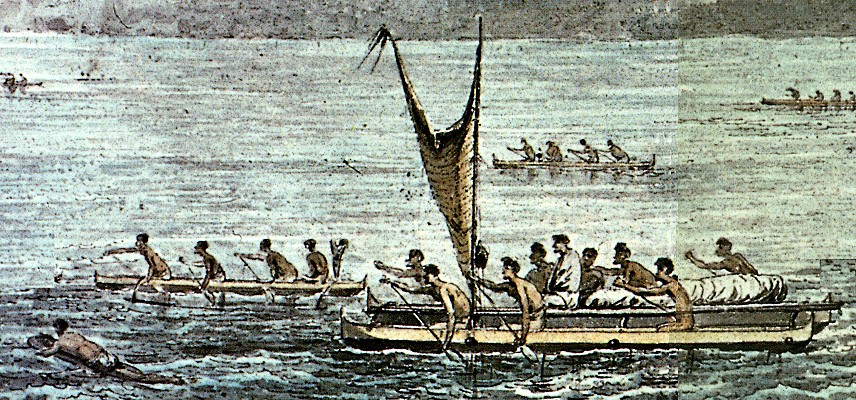
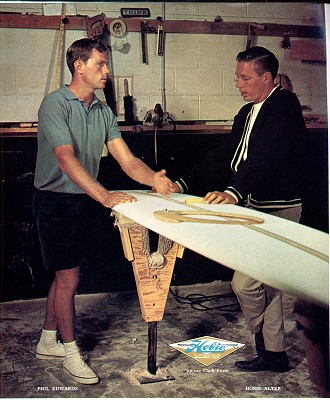 |
The
surfboard is a direct descendant from man's first
open-ocean watercraft, the wooden swimming float
(Hornell, 1946), which was, as the name implies,
instrumental in the development of the art of
swimming, an essential, though often overlooked,
component of surfriding, and water sports generally Its role as a mode of transport, as a paddleboard, was still common in Hawai'i, illustrated here by Webber, and as first reported by members of Cook's expedition. While surfriding, on boards, in canoes , and/or as bodysurfing, was practised throughout Polynesia, it was most developed in Hawai'i; the largest tropical landmass with the richest natural resources, the largest population, and the best surfing conditions. Whereas, in fact, most ancient surfers probably rode prone, in Hawai'i, riding while standing on their larger alaia surfboards was marked as the highest degree of skill, which became the modern norm. Crucially, when standing, the rider adopts an off-set stance, with a leading and a trailing foot (usually identified as natural or goofy), and characteristic of all subsequent board sports- skateboard, sandboard, snowboard, sailboard, wakeboard, kiteboard, not to mention, the (expletive deleted), stand-up-paddle board. The Hawai'ian alaia surfboard, hand-carved from a single timber billet, was essentially replicated well into the 1940s. In 2013, the numerous descendents of the alaia are almost too tedious to mention, see above, but also note the surfoplane, the coolite, the surfmat, the boggie board, the surf-ski, the wave-ski, and the rescue paddleboard. Born in California in 1933, Hobart "Hobie" Alter began surfing in the late 1940s at Laguna Beach, riding the recently introduced Malibu board, largely the work of master-shaper, Joe Quigg. Quigg's prototype was the Darrylin board, originally constructed in 1947 for the teenage daughter of Hollywood mogul Darryl Zanuck, it was ridden and praised by the Malibu elite. A shorter, thin balsa wood blank, laminated with fibreglass and with a large short-base fin, this lightweight board revolutionised surfriding; for the experienced rider it vastly extended the range of suitable surf conditions, offered a dramatic increase in performance, and opened boardriding to a wider population, or, as some would say, "market." As surfboard builders had exploited the introduction of marine glues following WWI, laminated fibreglass, developed in WWII, was initially used to attach fins and strengthen the nose, before the practice of fully enclosing the blank was adopted. Although the concept was "space-age," the timber blank was still hand-shaped along the grain, the standard method since pre-history. Initially building boards in the family garage from 1950 to 1953, the next year Alter opened Hobie Surfboards at (Richard) Dana Point; named after the author of the 1840 classic American narrative Two Years Before the Mast. Whatever Hobie's excellent skills in marketing surfing, they could not compare to the global impact of another teenage female surfer from Malibu, Kathy Kohner. Appearing as Gidget in her her father's novel of the same name, it sold over 500,000 copies in 1957, and filmed in 1959. The "surf craze" was further extended by the popularity of surf music, most notably the work of The Beach Boys, under the leadership of Brian Wilson. As Hobie's business expanded, he and board glasser, Gordon "Grubby" Clark, researched and developed a polyurethane foam blank as a commercially viable alternative to balsa, and in 1958 foam replaced balsa on all Hobie surfboards, a move quickly followed by most manufacturers. If the use of laminated fibreglass was said to be "space-age," foam certainly was. Foam blanks could be blown to any size required, and, although most foam blanks have a central timber stringer, its relative softness and the lack of a grain substantially reduced labour. But most significant advantage was a considerable reduction in surfboard weight. California's prime large-wave break during the summer, Dana Point would later house, along with Hobie Surfboards, the offices of John Severson's, Surfer magazine (1960- ) and Bruce Brown, the producer of the surfing's most successful film, The Endless Summer (1964-1966). It must be noted that all three surfers were highly proficient, indicated by both their documented performance and their ongoing commitment to advancing the art to its highest level. Dana Point's hottest surfer, however, was Hobie's first appentice, Phil Edwards, who by 1964 was recognised, certainly by Severson, Brown, and Hobie (dubbed the Dana Point Mafia, probably by Malibu’s Micki Dora), as the world's best. Throughout the 1960s, Hobie lead the industry producing up to 6,500 boards annually, and the Hobie team featured the cream of surfing's elite. As well as Edwards, the roster included multi-World champion Joyce Hoffman, US champion Corky Carroll, East Coast champion Garry Propper, Makaha and Duke champion Joey Cabell, renowned shaper of big-wave "guns," Dick Brewer, and Mickey Munoz, one of the first to ride Waimea Bay in 1957 and who surfed as Gidget in the 1959 film. Hobie's activities were not restricted to the surfboard factory. With partner Laurie Hoover, he won several tandem titles surfing up to 1963, to promote the sport, in 1965 he wake-surfed 30 miles from Long Beach to Catalina Island, and served on the board of the United States Surfing Association. However, the most significant was probably the launch of Hobie Skateboards in 1964. |
| See the new Phil Edwards model Hobie
Surfboard. Each board shaped by Phil. Photo: Del Cannon, Hobie shaper. Surfer Volume 4 Number 3 June-July 1963, page 1. |
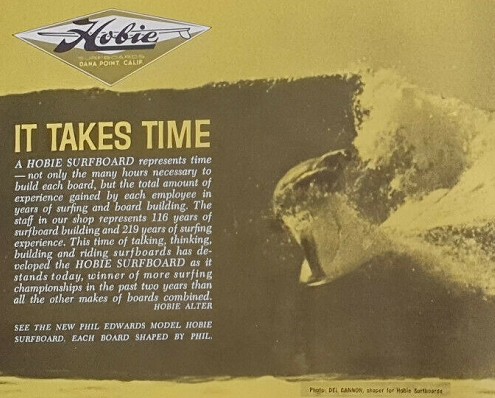 |
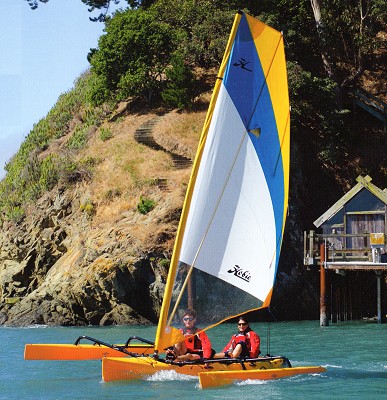 |
Across
ancient Oceania, the
dugout outrigger canoe was the standard vessel,
primarily used for fishing, and its use continues
today. In the late 1890s surfing in canoes became a popular tourist attraction at Waikiki with the formation in 1897 of the Hui Pakaka Nalu by native canoe owners, under the management of W. W. Dimond The Hui Pukaka Nalu advertised their services for $1.00 an hour in the local press and was a significant presence on the beach, with up to eight canoes regularly in action. In this era, the outriggers were also paddled and sailed competitively at the Waikiki Regattas. In 1905 the outrigger canoe was integrated into the seal of the County of Ohau, and action photographs appeared regulary in the press in the following years. Its status was firmly entrenched at Waikiki with the formation of the famous Outrigger Canoe Club in 1908, under the leadership of Alexander Huime Ford. Possibly influenced by Sydney's
fledging surf lifesaving clubs on his visit there in
1907-1908, he crucially, secured a
long-term lease on prime beachfront property, occupied
until 1963, when the club relocated to their present
site.
Since the turn of the twentieth century, recreational canoes have been produced in a vast range of designs, although the Canadian canoe and the Kayak could be said to predominate. Initially constructed with marine plywood, they were later built of fibreglass, rotomoulded plastic, and, in Olympic class canoes, carbon fibre. In 2008, the Hobie company, now run by his children, revolutionised recreational canoeing with the introduction of a range of rotomoulded "Kayaks" and "Boats" featuring the remarkable Mirage (Penguin) Drive. As expected of the company, all the designs and components were robust, user-friendly, and highly efficient. The top-of -the-line Mirage Adventure Tandem Island is a formidable craft, with twin outriggers, adjustable trampolines, adjustable daggerboard, dual penguin drive, and a self-furling sail |
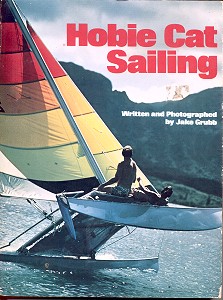 |
The Polynesian double-hulled sailing canoe served as
a royal barge, a ship of war, and as transportation on
their major voyages of discovery and settlement. With Western contact, its use was virtually discontinued as the chiefs adopted European vessels, braced with iron, as only these withstood the stresses of canon fire. The double-hulled sailing canoe reappeared in Waikiki Bay in 1947, when Woody Brown launched the Manu Kai (Sea Bird) , the first modern, ocean-going catamaran. A pioneer glider pilot, Woody Brown began surfing in California in the 1930s, and built his first hollow plywood surfboard with small keel, or skeg, in 1936, similar to Tom Blake's renowned design. He moved to Hawaii in 1940, and became one of Hawaii's first big wave surfers and board designers, noteably in the development of the fin-less Hot Curl, incorporating a deep V-bottomed tail that significantly improved the control. In 1953 Thomas Tsuzuki photographed Brown, George Downing and Buzzy Trent riding large Makaha. Extensively reprinted in the press, it initiated the ongoing challenge to ride the biggest (documented) wave. Note, however, that on first impression the image is misleading, and if it is correctly aligned with the horizon, is somewhat less dramatic. |
It is unnecessary
to relate the development of engine-powered catamarans, vessels
of this description to be seen in every harbour of the world,
other to note that this started reasonably early.
See:
Queensland State Library.
File:StateLibQld 1 251308 Two young men having fun with their
home-made watercraft on the Brisbane River.jpg
While the Hobie Cat derived from the Polynesian double-hulled sailing canoe, as modernized by Woody Brown in 1947, it is not true that the design was completely ignored by the sailing establishment before this.
Epilogue
|
Bob Cooper: Magic Surfing World Volume 14 Number 4, circa August 1970 pages 14 to 17. |
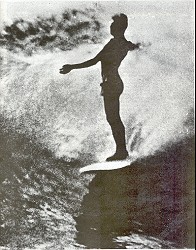 |
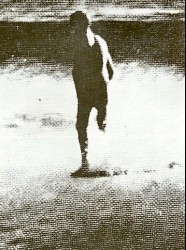 |
Bob Cooper: Magic Surfing World Volume 14 Number 4, circa August 1970 pages 14 to 17. |
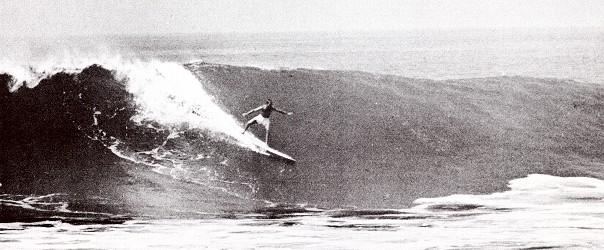 |
Stern and Cleary: Surfing Guide (1963) page 166. Photograph: Bruce Brown |
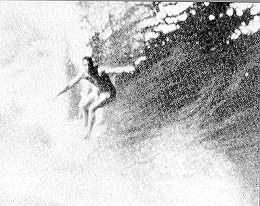 |
See Source Documents: 1963 Bruce Brown : Phil Edwards at Pipeline, 1961. |
|
Surfer Magazine Volume 25 Number 1 page 30. |
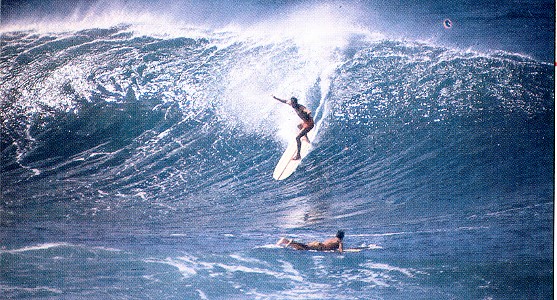 |
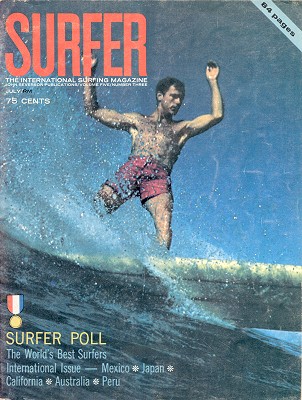 |
Surfer
Magazine |
| Edwards, Phil with Ottum, Bob
: 1967 You Should Have Been Here An Hour Ago - The Stoked Side of Surfing or How To Hang Ten Through Life and Stay Happy Harper and Rowe 49 East 33rd Street New York, NY 10016 Hard cover, 179 pages, 71 black and white photograghs, 2 black and white illustrations Review In many aspects, an unique surfing book. Excerpt : Plans and Specifications : 1965 Phil Ewards' Hobie Nose-Rider |
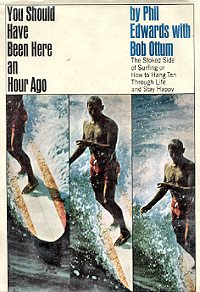 |

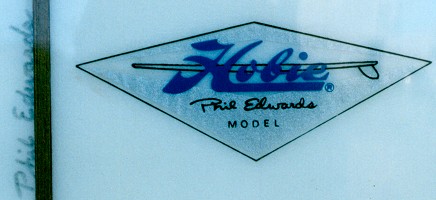
| home | catalogue | history | references | appendix |